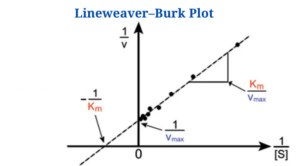Lineweaver–Burk Plot
- Because Vmax is attained at endless substrate concentration, estimating Vmax and thus Km from a hyperbolic plot is impossible.
- Due to this issue, Lineweaver and Burk modified the Michaelis–Menten equation into a straight line equation.
- The Lineweaver–Burk plot (also known as the double reciprocal plot) is a pictorial depiction of the Lineweaver–Burk equation of enzyme kinetics, which was presented by Hans Lineweaver and Dean Burk in 1934.
- This figure is derived from the Michaelis–Menten equation and is denoted as follows:
where V represents the reaction velocity (reaction rate), Km denotes the Michaelis–Menten constant, Vmax denotes the maximum reaction velocity, and [S] denotes the substrate concentration.
- It produces a straight line with a y-axis intercept of 1/Vmax and an x-axis intercept of Km/Vmax. The slope of the line is equal to Km/Vmax.
- Vmax and Km can be calculated experimentally by measuring V0 at various substrate concentrations. Then, for 1/V0 vs 1/[S], a double reciprocal or Lineweaver–Burk plot is generated.
- A Lineweaver–Burk plot can be used to discriminate between competitive and noncompetitive reversible enzyme inhibitors.
- It is an effective method for determining how an inhibitor interacts to an enzyme.
- If V0 is measured at multiple substrate concentrations in the presence of a fixed dose of inhibitor, a Lineweaver–Burk plot can be used to detect competitive inhibition.
- On the Lineweaver–Burk plot, a competitive inhibitor increases the slope of the line and changes the intercept on the x-axis (because Km is increased), but leaves the intercept on the y-axis unaltered (since Vmax remains constant).
- Noncompetitive inhibition can also be identified on a Lineweaver–Burk plot because it raises the slope of the experimental line and changes the intercept on the y-axis (due to a drop in Vmax), but leaves the intercept on the x-axis unaltered (since Km remains constant).
Uses of Lineweaver–Burk Plot
- Before the widespread availability of powerful computers and non-linear regression software, this method was used to calculate crucial parameters in enzyme kinetics, such as Km and Vmax.
- Provides a rapid graphic representation of the various types of enzyme inhibition.
Lineweaver–Burk Plot Citations
- David Hames and Nigel Hooper (2005). Biochemistry. Third ed. Taylor & Francis Group: New York.
- Smith, C. M., Marks, A. D., Lieberman, M. A., Marks, D. B., & Marks, D. B. (2005). Marks’ basic medical biochemistry: A clinical approach. Philadelphia: Lippincott Williams & Wilkins.
- https://en.wikipedia.org/wiki/Lineweaver%E2%80%93Burk_plot
Related Posts
- Phylum Porifera: Classification, Characteristics, Examples
- Dissecting Microscope (Stereo Microscope) Definition, Principle, Uses, Parts
- Epithelial Tissue Vs Connective Tissue: Definition, 16+ Differences, Examples
- 29+ Differences Between Arteries and Veins
- 31+ Differences Between DNA and RNA (DNA vs RNA)
- Eukaryotic Cells: Definition, Parts, Structure, Examples
- Centrifugal Force: Definition, Principle, Formula, Examples
- Asexual Vs Sexual Reproduction: Overview, 18+ Differences, Examples
- Glandular Epithelium: Location, Structure, Functions, Examples
- 25+ Differences between Invertebrates and Vertebrates
- Lineweaver–Burk Plot
- Cilia and Flagella: Definition, Structure, Functions and Diagram
- P-value: Definition, Formula, Table and Calculation
- Nucleosome Model of Chromosome
- Northern Blot: Overview, Principle, Procedure and Results

















